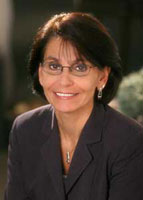JUST VISITING Don Michne of Miller Place took this photo of a flock of wild turkeys on Aug 19. He writes, “These are ‘my’ turkeys playing ring around a rosey. They visit me at least twice a day. If they can’t find me, they look all around the house and today they actually came into the garage.”
Yearly Archives: 2017
SBU’s Laurie Shroyer’s cardiac bypass study shows pump benefits

By Daniel Dunaief
To use the pump or not to use the pump? That is the question heart surgeons face when they’re preparing to perform a surgery that occurs about 145,000 times a year in the United States.

Called coronary artery bypass graft, surgeons perform this procedure to improve blood flow to a heart that is often obstructed by plaque. Patients with severe coronary heart disease benefit from a technique in which an artery or vein from another part of the body is inserted into the heart, bypassing the blockage.
Doctors can perform the surgery with a heart-lung machine, which is called on pump, or without it, which is called off pump.
Recently, a team of researchers led by Laurie Shroyer, who is a professor of surgery and the vice chair for research at the Stony Brook University School of Medicine, published a study in the New England Journal of Medicine that compared the survival and health of 2,203 veterans five years after surgery, with or without the pump.
Contradicting some earlier research that showed no difference in the health and outcomes after the surgery, the study revealed that using the pump increased the survival rate and reduced the rate of other health problems.
Along with the other research articles in this area, this study “should help in deciding the relative value and risks of each technique,” Frederick Grover, a professor of cardiothoracic surgery in the Department of Surgery at the University of Colorado, explained in an email.
The study Shroyer led, which is known as the Rooby trial, showed that on-pump patients had a five-year mortality of 11.9 percent, compared with 15.2 percent for the off-pump patients, Shroyer explained.
The five-year rate of medical complications, including death, nonfatal heart attacks and revascularization procedures was also lower for the on-pump group than the off-pump group, at 27.1 percent compared to 31 percent, respectively.
Consistent with these findings, the overall use of off-pump procedures has declined, from a peak of 23 percent in 2002 to 17 percent in 2012, down to 13.1 percent in 2016, according to data from the Society of Thoracic Surgeons Adult Cardiac Surgery Database Committee.
At one point, surgeons had considered an off-pump approach to be safer, but when other trials didn’t show a benefit and when the current Rooby trial demonstrated on pump had better outcomes, it “likely influenced many surgeons to use the off pump less often for specific reasons, considering it is a somewhat more difficult technique except in the most experienced hands,” Grover wrote.
The explanation for the difference five years after surgery are “not clear,” Shroyer explained in an email. The article suggests that the off-pump patients had less complete revascularization, which is known to decrease long-term survival.
Grover explained that the outcomes may have been better for the on-pump procedures in the Rooby trial for several reasons, including that the surgeons in the different trials had different levels of experience.
Leaders of the study suggested that patients and their surgeons needed to consider how to use the information to inform their medical decisions. Participants in the study were men who were veterans of the armed services.
“The data can likely be extrapolated to the general population since it is not an extremely high-risk population, but it is all male so would primarily extrapolate to males,” Grover suggested. Additionally, patients with specific conditions might still have better outcomes without the use of a pump.
“Our manuscript identifies an example for ‘patients with an extensively calcified aorta, in whom the off-pump technique may result in less manipulation of the aorta, potentially decreasing the risk of aortic emboli or stroke,’” Shroyer wrote in an email. Grover also suggested people with severe liver failure also might want to avoid the pump to prevent additional harm to the liver.
Shroyer and her team have already submitted a proposal to the VA Central Office Cooperative Studies Program. “Pending approval and funding, 10-year follow-ups will be coordinated appropriately,” Shroyer said.
Grover described Shroyer as a “spectacular investigator with a very high level of knowledge of clinical research” and, he added, a “perfectionist.” When he met Shroyer, Grover said he was “blown away by her intelligence, experience, background and energy.” He interviewed her many years ago to direct a major VA Cooperative Study. After the interview and before the next meeting, he called another interviewer and asked if he, too, agreed to hire her on the spot.
Grover recalled a trip back from Washington to Denver 15 years ago after they had been in a 10-hour meeting with no scheduled breaks. She took out her laptop on the airplane and asked him to write up results for a new grant.
“I was beat and finally said if she didn’t let up, I was going to jump out of the airplane just to get away from her,” he recalled. She shut her computer, ordered drinks and they enjoyed a peaceful flight back.
A resident of Setauket, Shroyer lives with her husband Ken, who is the chair of the Department of Pathology at Stony Brook School of Medicine. The professor said she loves the Staller Center, which she considers one of the greatest kept local secrets. She appreciates the opportunity to hear classical music performances by the Emerson String Quartet and by cellist Colin Carr.
When she entered biomedical research in 1992, it was unusual for women to rise to the level of full professor at an academic medical center. She strives to be an outstanding mentor to her trainees, including women and under-represented minorities, so that they can achieve their potential, too. As for her work, Shroyer’s hope is that the Rooby research “will provide useful information to guide future changes in clinical care practices” and, in the longer term “to improve the quality and outcomes for cardiac surgical care.”
Scarecrow Contest underway in Stony Brook Village
The Ward Melville Heritage Organization is currently accepting submissions for its annual Scarecrow Competition. Sponsored by The Suffolk Center for Speech and Myofunctional Therapy, Samuel R. Taube, Sharon Doyle, J. Robert Quilty and Roseland School of Dance, this will be the 27th year the spooky, silly, scary six-foot creations will adorn the pathways of picturesque Stony Brook Village Center for visitors to enjoy and vote for their favorite.
 As in the past, in recognition of Breast Cancer Awareness Month, all scarecrows decorated with a majority of pink will receive 50 bonus points toward the competition. Official entry forms are available in most Stony Brook Village Center shops, at the offices of WMHO at 111 Main Street, second floor, in Stony Brook or online at www.stonybrookvillage.com.
As in the past, in recognition of Breast Cancer Awareness Month, all scarecrows decorated with a majority of pink will receive 50 bonus points toward the competition. Official entry forms are available in most Stony Brook Village Center shops, at the offices of WMHO at 111 Main Street, second floor, in Stony Brook or online at www.stonybrookvillage.com.
Categories are divided into Professional, Adult/Family and Children’s. Registration deadline is Sept. 29 and there is an entry fee of $15. Winners will receive cash prizes awarded at WMHO’s annual Halloween Festival, beginning at 2 p.m. on Oct. 31. Visitors to the Stony Brook Village Center shops have the opportunity to cast their vote for their favorite scarecrow during the month of October. Voting ballots will be available in all Village Center shops and eateries or at the WMHO office. For full information on this and other Stony Brook Village events, call 631-751-2244 or visit www.stonybrookvillage.com.![]()
Your Turn: More action needed to combat drug abuse in Three Village
By Donna Newman
At a recent meeting of the Three Village Drug & Alcohol Awareness Program — a support group that seeks to educate all and assist parents and family members of teens and young adults battling substance abuse — I spoke with a young mother of elementary-school-age children. She was there to learn about this growing danger that has taken so many lives in Suffolk County. She is afraid for her children. They are growing up in a society where drug overdose deaths have become routine. She wants to protect her children from becoming victims of substance abuse.
This mom has been on a crusade to make parents aware of the dangers, knowing that this is a Three Village problem and it will take community awareness and extensive effort to combat it. So she speaks to parents of young children wherever she finds them to encourage them to be part of the solution. She told me the majority response from parents is: “Not my kid. She’s an A student.” Or, “Not my kid, he’s an athlete.” Or simply, “My child would never get involved in that.”
I’m here to tell you that you need to take your head out of the sand.
The significant drug problem at Ward Melville High School when my sons were in attendance in the 1990s was not publicly acknowledged by the school district — or anyone else other than the parents whose children “got into trouble.” Mine did not. They were honor grads, heavily involved in extracurricular activities.
However, in a conversation with one of my sons, years after graduation, I learned he had used drugs with some regularity while in high school. It turned out I had been one of those clueless parents. But I was one of the lucky ones.
Lucky, because back then, when a teenager bought marijuana, it was just pot. It was not the cannabis of today, which may be laced with illicit and scary drugs by dealers seeking to hook kids on stronger stuff. Lucky, because he did not have a propensity, and his “recreational” use never rose to the level of addiction.
Full disclosure: As a college student in the 1960s I experimented with marijuana as well. My equally clueless mother discovered a small baggie of weed in my room. She trashed it, never saying a word to me. In that era, just knowing she knew was enough to get me to stop.
The school district has finally acknowledged the fact that addiction is a disease requiring treatment, not a moral lapse requiring punishment.
According to “School district welcomes new drug and alcohol counselor” in the July 20 edition of The Village Times Herald, the district has hired a substance abuse counselor. Heather Reilly, certified social worker, will be tasked with rotating through the secondary schools one day each week (including the Three Village Academy alternative high school program), providing substance abuse counseling, educating faculty about warning signs and drug lingo, and creating educational curriculum for sixth-graders in collaboration with elementary health teachers. She will also be available to work directly with families.
While this is a laudable first step, it’s not nearly enough. Change will not happen without a concerted community effort. Parents need to accept the fact that this is a real problem affecting Three Villagers across the cultural and economic spectrum. Yes, it could even be your child.
Folks must come to grips with the fact that chemical dependency is a potentially fatal illness and that 90 percent of sufferers go untreated. They need to acknowledge that kids who are addicted to alcohol and/or opioid drugs are not “bad” kids. They are youngsters whose brains are not fully developed, who made bad choices that led to a tragic outcome. It’s time for all of us to learn all we can about prevention and to come together to end this plague.
There’s a lot you can do. For starters, attend the monthly meetings at the Bates House in Setauket. Dates and times are listed on Facebook on the Three Village Drug & Alcohol Awareness Parent Group page — along with other helpful information. Learn when and how to begin to talk to your child about the dangers of alcohol and drugs and your family’s rules concerning underage drinking and substance abuse. A good place to begin is at New York State’s online site www.talk2prevent.ny.gov.
The next meeting at the Bates House, located at 1 Bates Road in Setauket, will be held Sept. 24 at 7 p.m.
Donna Newman, a freelance writer, is a former editor of The Village Times Herald.
Little Free Library pops up in Terryville
The historic Terryville Union Hall is the latest recipient of a Little Free Library, thanks to Comsewogue Public Library Director Debra Engelhardt and the library, which stocked and funded the installation.
Pictured with Engelhardt are library staff members and local resident Angela DeRosalia, who hand-painted the kiosk, Councilwoman Valerie Cartright (D-Port Jefferson Station), Northern Brookhaven Chamber of Commerce President Jennifer Dzvonar and member Lisa Molinelli, who brought their children to ‘leave a book, take a book.’
Joining them is Terryville Road Elementary School Principal April Victor with supportive parents and students and Cumsewogue Historical Society President Jack Smith, Vice President Joan Nickeson, Treasurer Lou Antoniello and member Jackie Kirsch, who donated a collection of popular tween books.
Cooking Cove: Recipes for picky pickle eaters
By Barbara Beltrami
If you’re not picky about your pickles, you should be because there’s no comparison between homemade and commercially prepared ones. Although you need an uninterrupted couple of hours and a few special pieces of equipment to “put up” a batch of pickles, once you’ve made the investment of time and supplies, you’ll be hooked and do it every year.
Two great moments of culinary satisfaction happen first when you hear the sound of the jar lids popping to release the air and vacuum seal the jar and later when you stand back and regard the row of pickle jars sitting like so many green soldiers on your pantry shelf.
Here is a list of canning supplies available in most local hardware and agricultural supply stores. You most likely already have many of these things in your kitchen.
Large enamel pot with canning rack
Large pot for boiling pickles
Glass jars with ring and dome lids
Large spoons and ladles
Sharp knives and vegetable peelers
Large colander
Kitchen scale
Measuring cups and spoons
Wide-mouth funnel to fit circumference of jar tops
Cheesecloth
Timer
Tongs
Pot holders
A few precautionary tips: Jars should be unchipped; veggies should be fresh and unspoiled; after processing, jars should be closed tight with a small dent in the middle of the lid; jars, domes and rings and implements must first be sterilized in a hot water bath or the dishwasher for at least 15 minutes. Now that you’ve got it all together, you’re ready to start making your own pickles!
Bread and Butter Pickles

YIELD: Makes 7 to 8 pints
INGREDIENTS:
4 pounds medium or Kirby cucumbers, washed and cut into ¹/₄-inch slices
1 pound small white pearl onions (frozen are OK)
1 green bell pepper, cored, seeded and sliced thin
1 red bell pepper, cored, seeded and sliced thin
½ cup kosher salt
3 quarts ice water
5 cups sugar
5 cups cider vinegar
2 tablespoons mustard seed
1 teaspoon celery salt
1 teaspoon ground turmeric
1 teaspoon ground ginger
1 teaspoon peppercorns
DIRECTIONS: In a large bowl, combine cucumbers, onions and peppers. Add salt, mix well and add three quarts ice water. Cover and let sit for 4 hours. Fill canning pot to indicated water level, cover and bring to a boil. In a large pot, mix remaining ingredients and bring to a boil; let boil 3 minutes. Meanwhile, drain the vegetables, rinse thoroughly and drain again. Add veggies to liquid and bring to a boil again. Remove from heat and pack into hot one-pint sterile jars; leave ¼ inch headroom.
With a damp paper towel, wipe the top and side rims of the jars; with tongs place domes on jars, then screw on rings just to the point of stopping; do not tighten. Using tongs or pot holders, carefully set jars on raised rack of canning pot, then gently, being careful not to topple any jars, lower the rack into the hot water, cover and return to boil. Process (boil) for 10 to 15 minutes. Turn off heat.
With tongs or pot holders, raise rack and remove jars onto heat-proof surface. As you lift them out, you will probably hear them popping, which means they’re sealed. With your finger, poke any that do not have a slight indentation in the middle. If they still have a slightly raised surface in the middle after several attempts to depress them, put them aside, and when cooled, refrigerate and use within a week or two.
Dill Pickles

YIELD: Makes about 7 pints
INGREDIENTS:
¾ cup sugar
½ cup kosher salt
1 quart white vinegar
1 quart water
3 tablespoons mixed pickling spices
2 cloves garlic
35 medium Kirby cucumbers, sliced in half lengthwise or cut into spears
7 to 8 heads fresh dill
DIRECTIONS: Have canning pot and rack ready with boiling water reduced to simmer. Combine sugar, salt, vinegar and water in medium pot. Tie pickling spices and garlic cloves in a cheesecloth bag and add to mixture. Simmer for 15 minutes; remove and discard bag. Meanwhile, pack cucumbers into hot sterilized pint jars and add one head dill to each jar; leave half an inch headroom. Bring vinegar mixture to a vigorous boil and ladle hot brine over cucumbers; leave ¼ inch headroom. Proceed as in italicized part of previous recipe.
Stony Brook church members race to raise funds
Members of a local congregation will be pounding the pavement Oct. 1 to raise funds for their historic church, one that was designed by renowned architect Stanford White in 1889.
All Souls Episcopal Church’s 90 members are inviting runners and walkers of all ages and denominations to join them as they participate in the 9th annual Soles for All Souls 5K Race/2K Walk. Dan Kerr, race and church membership chairperson, said it’s the second year he is heading up the event. His wife Susan Kerr and friend Mary Ellen Doris started the race after the late priest in charge, Mother Ann Plummer, asked members, “Why don’t you do something to get the community more active.”

Susan Kerr, the church’s head of fundraising, said Doris suggested the race, but she herself was skeptical at first if the church committee could pull it off. However, Doris had experience with running and was confident that it would be a success, and the first year they attracted approximately 100 runners.
The two organized the race together every year until Doris moved to South Carolina. Kerr continued to chair the race until her job as a physical therapy assistant required her to work more hours. That’s when she passed the baton to her husband, and he stepped in to head up the race.
Relieved of her organizational duties, Kerr said last year at 62 years old she competed in her first race and came in first in her division in Soles for All Souls. She said as a former power walker, who began her quest to run by taking it one mailbox at a time, she believes anyone can take up running.
“Enjoy the process and compete only against yourself,” she said.
Kerr said her husband has been doing a great job organizing the race these last two years. She said he is fastidious in his organization and has taken the event to the next level and brought in more sponsors.
“He really knows how to get out there and get sponsors, advertising on the back of shirts,” she said.
Dan Kerr said approximately 120 serious and casual runners and walkers participated in last year’s race. He said his wife and Doris carefully planned the route before the first race in 2009 wanting to make sure it was exactly five kilometers and both challenging and scenic.
“The people who run it tend to be people who are serious runners,” he said. “They run in a lot of races, and they always tell us our race, although it’s small, is one of the best planned and has one of the most beautiful routes, especially when they come to the end when they come down Sand Street on the last leg and they get to run along the harbor.”

Runners prepare for last year’s Soles for All Souls race. Photo from All Souls
The church’s senior warden Steven Velazquez has run in the race for five years along with his daughter Veronique, while his wife Suzanne helps at the event. He said the fundraiser brings the members of the church together as they promote and work on it, and Dan has been doing a phenomenal job.
“It connects our small church together, it binds us together,” Velazquez said.
He said many children run in the race, and now that they’re getting older, keeping up with them is becoming more challenging. While he used to run on a regular basis and participate in Northport’s Great Cow Harbor 10K Race, he broke his leg a few years ago and hasn’t been able to run as much in recent years.
“I’m not the greatest runner but I’m happy to complete it,” he said.
The race begins at 9 a.m. Oct. 1 rain or shine. To register, go to www.active.com and search for Soles for All Souls. Fee is $25 for adults and $10 for children under 18 before Sept. 24 and $30 for adults and $15 for children afterward and on the day of the race. The day will include pre-race stretching led by Inspired of Port Jefferson, and the band Down Port will perform after the race. Nonperishable food items and toiletries will be collected for the food pantry at St. Cuthbert’s Church in Selden.
All Souls Episcopal Church is opened every day to visitors and located at 61 Main St., Stony Brook.
Operation Rejuvenation marches forward at Long Island State Veterans Home

Ribbon cutting ceremony officially opens first renovated residential unit
The Long Island State Veterans Home in Stony Brook recently celebrated a milestone in Operation Rejuvenation, a project that will help renovate the interior of the existing facility, with the opening of its first renovated residential unit, 3C. The event was celebrated with a ribbon cutting on Aug. 25.
The project was made possible by a $12.5 million VA Construction Grant, one of the oldest partnerships between the federal government and the states. Each year, through the support of Congressman Lee Zeldin (R-Shirley), the federal government allocates approximately $85 million to fund the State Veterans Home Construction Grant Program. Through this initiative, individual states compete for funding that must be used to either construct or renovate designated state veterans facilities that provide skilled nursing or domiciliary care.
The federal government appropriates 65 percent of the construction costs provided that each state makes a commitment of 35 percent in state matching funds, for which New York State Senator John Flanagan has been instrumental in helping the LISVH secure.
The newly renovated nursing units include a modernized and open dining space, an accessible nourishment station, a complete nursing station redesign and fully renovated living spaces for residents. This project included the installation of energy-efficient LED lighting, LED televisions and new personal furnishings that our nation’s heroes will be proud to call home.
“The Long Island State Veterans Home has always made a commitment to be the premiere provider for long-term care services to our nation’s heroes,” said Fred S. Sganga, executive director of the Long Island State Veterans Home. “Operation Rejuvenation will assure that our frail, elderly veterans are living in the finest facility in the country. We are really excited about this project because it represents the recommitment of Stony Brook University to Long Island’s veterans and their families.”
“Our veterans were willing to put themselves in harm’s way in order to protect our freedom and way of life,” said Zeldin. “We owe it to them to make sure the facilities that care for our veterans are in the best condition possible to meet their needs. The work being done at the Long Island State Veterans Home will help accomplish that goal, and I commend the leadership and staff for undertaking this project.”
“Our nation owes a debt of gratitude to those who have protected our way of life and cherished freedoms,” said Flanagan. “One way we can say ‘thank you’ to them is by making sure these brave men and women have a comfortable living environment. The Long Island State Veterans Home has been a great resource for our veterans and their families and this project will help ensure that it continues to be a place that our heroes are proud to call home,” he said.
Legally Speaking: Is a credit shelter trust still the best option?

By Linda Toga

THE FACTS: I had my will prepared years ago. The estate tax exclusion amount at the time was considerably less than it is now, so my will contains a provision that directs my executor to create a credit shelter trust to avoid estate taxes. The trust provision mandates that the credit shelter trust be funded with assets equal in value to the estate tax exemption amount in effect at the time of my death.
THE QUESTION: A friend told me the credit shelter trust language that is currently included in my will could result in only a small part of my estate, if any, passing directly to my wife. Is he correct?
THE ANSWER: Without knowing the size of your estate, it is impossible to say how much of your estate might pass directly to your spouse upon your death. That being said, your friend is correct.
Credit shelter trusts are designed to avoid estate tax, but tax avoidance is generally not an issue when the first spouse dies because the surviving spouse is most often the beneficiary of the deceased spouse’s estate.
Regardless of the value of the assets that pass to a surviving spouse as sole beneficiary, there will be no estate tax liability on the first death because both the federal and New York State tax codes include an unlimited marital deduction. That means the assets passing to the surviving spouse pass estate tax free.
In contrast, the value of assets passing to a nonspouse may trigger estate tax. That is why estate tax can become a problem when the surviving spouse dies. If the value of the surviving spouse’s estate exceeds the applicable estate tax exemption amount then in effect, estate tax will be due. This year the federal estate tax exemption is currently at $5.49 million and the New York State exclusion amount is currently at $5.25 million.
If your will directs that assets equal in value to the current estate tax exemption amount go into the credit shelter trust, over $5.2 million of your probate estate must be used to fund the trust. The actual dollar amount will depend on whether your will references the federal or the New York State exemption/exclusion amount. If the value of your assets does not exceed the exemption amount, the only assets passing directly to your spouse will be jointly held assets and assets on which she is a named beneficiary. Assets that are used to fund the trust will be available to your spouse under certain conditions. She will not have unfettered access to those funds.
Credit shelter trusts were very popular with my clients when the estate tax exclusion amounts were significantly smaller. In 2008, for example, when the federal estate tax exemption was $2 million, clients with estates valued at $3 to $4 million felt comfortable funding a credit shelter trust since the surviving spouse would still receive $1 to $2 million outright. However, since the exclusion amount has increased at a much faster rate than the value of most people’s estates, the language in many credit shelter trusts has become a problem.
One way to address the problem is to have a new will prepared that does not direct your executor to create a credit shelter trust. However, if you are concerned about estate tax liability, another option is to have a new will prepared that includes language limiting the value of the assets that must be used to fund a credit shelter trust. That way you can be sure that there are sufficient assets passing to your spouse outright.
A third option is to include a discretionary marital trust in your will, rather than a credit shelter trust. A disclaimer trust, for example, can be used by married couples to avoid estate taxes and has the advantage of allowing the surviving spouse to decide how much money will go into the trust. If the surviving spouse feels comfortable doing so, she can have the trust funded with assets equal in value to the applicable exclusion amount. However, she can also decide to fund the trust with a lesser amount or to not to fund the trust at all.
The surviving spouse has nine months to decide whether it makes sense taxwise to fund the trust. Because of the flexibility offered by disclaimer trusts, and the ability to essentially do post-mortem planning, many people whose estates are valued at over the exclusion amount find disclaimer trusts a good option. To figure out what would be best for you, you should discuss your situation with an experienced estate planning attorney.
Linda M. Toga, Esq. provides legal services in the areas of estate planning, probate, estate administration, litigation, wills, trusts, small business services and real estate from her East Setauket office.
Smithtown chocolatier runs for town supervisor
A Smithtown business owner has put her name on the November ballot to give residents a third option when voting for town supervisor.
Kristen Slevin, 40-year-old owner of Yottabyte Craft Chocolate and Candy in Smithtown, has launched her own independent campaign for Smithtown town supervisor. A prior vice president of Swan Lake Civic Association, this is her first time running for political office.
Slevin, a Smithtown resident and Hauppauge High School graduate, shed light on her jump from business owner to political candidate.

“As a business, we feel we are a member of the community, we have a voice and we should leverage our voices for things we believe in,” she said of her business perspective.
Slevin said after seeing her community get energized by the 2016 presidential election, she launched an advocacy group on Facebook titled Smithtown Election Watch 2017.
“People had all this energy and enthusiasm to get involved in national issues, meanwhile our local downtowns are disappearing right before us,” Slevin said.
Slevin and a team of approximately a dozen volunteers began July 11 rounding up 1,781 signatures from registered Smithtown voters, exceeding the minimum 1,500 required under state law, for an independent candidate to run in the general election. Her campaign slogan is “None of the Above.”
The independent campaign platform focuses on fixing an “obsolete” town code, addressing blight in the downtown business areas and the creation of historic districts and town council districts. One of the first projects on her radar, if elected, would be to embark on a full review of town code, its policies and procedures, as the candidate said she had found it difficult to read through and impossible to search.
“Other things I am concerned about are if the towns are suffering from intentional blight,” Slevin said. “Some landlords might have multiple properties, here or in other towns, that they allow this property to go vacant and are taking the tax credit against what they are making in more successful rentals.”
If elected, she said she would consider introducing new tax codes to increase rates on properties with long-standing vacant buildings to encourage owners to either rent or sell. Slevin said other municipalities in New York and other neighboring states have adopted such programs.
“People had all this energy and enthusiasm to get involved in national issues, meanwhile our local downtowns are disappearing right before us.”
— Kristen Slevin
In addition to addressing blight, the business owner said she’d like to see Smithtown, Kings Park and Lake Avenue in Saint James be recognized as historic districts.
“Our philosophy should be that they are quaint, small-town U.S. towns right here,” Slevin said. “While so many other places are being built up and becoming more city like, we are going to hold on to our small-town vision here.”
The candidate said she’s not against the integrated development of mixed-use properties that combine retail space with apartments designed for students, singles and senior residents. Slevin said it’s her belief that mixed-use properties would provide a more diversified business base and community that over time would strengthen the local economy.
Her platform also proposes splitting the Smithtown town board into council districts, similar to the Town of Brookhaven, to improve elected officials’ accountability.
“If everyone had their own councilperson elected from their district, they are both aware of the issues in their districts and they can be held accountable,” she said.
Slevin said she did weigh running for the town board seat prior to launching a campaign for supervisor. However, she felt that the town codes give the supervisor position significantly more power and control over other elected town officials, something she plans to remedy if elected.
Slevin will face off in the Nov. 7 against Democratic candidate William Holst (D) and the winner of the still undecided Republican primary between incumbent Supervisor Patrick Vecchio (R) and Councilman Ed Wehrheim (R). The Republican primary results will not be available until after Sept. 25.










